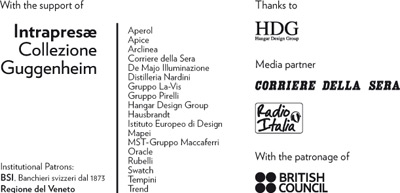The Vorticists:
Rebel Artists in London and New York, 1914-1918
29 January – 15 May 2011
701 Dorsoduro
30123 Venice
Italy
T +39 041 2405404/415
F +39 041 5206885
press [at] guggenheim-venice.it
www.guggenheim-venice.it
peggyg.mobi
Vorticism takes its name from “Vortex”, a term coined by the American expatriate poet Ezra Pound at end of 1913 when describing the “maximum energy” he and his colleagues wished to instill in London’s literary and artistic avant-garde. In 1914 the self-proclaimed leader of this new movement, Wyndham Lewis, founded the radical journal Blast, and within the pages of the first issue baptized the circle of painters, sculptors, and writers working in this new style as ”Vorticists.”
The exhibition opens with an introductory section of large-scale iconic works associated with Vorticism: Jacob Epstein’s Rock Drill (1913-15; a recreation of the original assemblage, plus the 1916 “torso” in bronze), David Bomberg’s The Mud Bath (1914), Henri Gaudier-Brzeska’s Hieratic Head of Ezra Pound (1914; 1973 authorized copy), and Wyndham Lewis’s The Crowd (1914-15). Painters and sculptors, they were surprisingly international and multi-denominational in their make-up: Epstein was American and Jewish, Bomberg was English and also of Jewish heritage, Gaudier-Brzeska was an expatriate from France, and Wyndham Lewis was Canadian by birth. By so introducing figures pivotal to Vorticism, the exceptional diversity of this movement is immediately underscored. And, via his effigy, the Vorticists’ major thinker, Pound, also figures prominently.
The core of the exhibition will then trace the evolution of Vorticism through the movement’s central exhibitions: the 1915 Doré Gallery show in London, the January 1917 Penguin Club exhibition in New York, and the February 1917 Camera Club exhibition of Vortographs in London. In each case, new research has been undertaken to identify and locate the works originally shown in these historic presentations. Additional components of the exhibition revolve around the two issues of Blast and feature literary ephemera and associated artwork by the group. These will highlight the production of Lewis and the prints of Wadsworth.
Although Vorticism initially emerged in England, its practitioners had important links to the American avant-garde, impacting such figures as the collector John Quinn, who, together with Ezra Pound, facilitated the introduction of Vorticism to an American audience. Conceived as a survey to introduce a non-British audience to this seminal movement, the emphasis on Anglo-American connections, combined with the recreation of Vorticism’s three exhibitions, is unprecedented.
The catalogue consists of a series of essays by British and American scholars who consider such themes as the critical reception of the Vorticists’ exhibitions, the impact of World War I on the cultural politics of the movement, the reception of Vorticism in the United States, and the leading role of Ezra Pound in shaping the movement.
To mark the opening of the exhibition, Saturday, January 29, the international symposium The Vorticists will take place in Venice, at the Auditorium Santa Margherita (Dorsoduro 3689), from 9:30 am to 6 pm. The symposium looks broadly at the artists and thinkers who contributed to the movement. It introduces students, scholars, and the general public to an avant-garde virtually unknown in this country. Nine international scholars will participate, each focusing on the core ideas of Vorticism’s main protagonists. Vivien Greene, co-curator of the exhibition, will be the moderator. This symposium has been made possible by The Gladys Krieble Delmas Foundation. Additional support has been received from The Henry Moore Foundation and Ca’ Foscari University.
The exhibition has the patronage of the British Council and has been supported by Intrapresae Collezione Guggenheim. Hangar Design Group realized the graphic design. Radio Italia and Corriere della Sera are media partners.
On the occasion of the exhibition, Gian Nicola Colucci, Executive Chef of Hotel Danieli, is creating a special Vorticist-inspired menu. The menu Vortices: Culinary Rebels will be available for lunch and dinner at the Restaurant Terrazza Danieli from January 29 through May 15, 2011.
Daily at 3:30 pm free guided visits of the temporary exhibition are offered to the public.
Opening hours: 10:00 am-6:00 pm; closed Tuesdays
THE VORTICISTS: REBEL ARTISTS IN LONDON AND NEW YORK, 1914-1918
January 29 – May 15, 2011
Peggy Guggenheim Collection
701 Dorsoduro
30123 Venice
ITALY
phone +39 041 2405404/415
fax +39 041 5206885
email press@guggenheim-venice.it
www.guggenheim-venice.it
peggyg.mobi
*Image above:
Collection of the Tate, London. Purchased 1949.
Image courtesy of Tate Photography.




